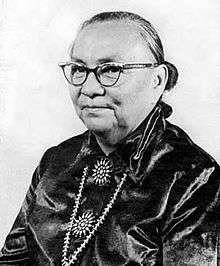Annie Dodge Wauneka
| Annie Dodge Wauneka | |
|---|---|
 | |
| Born | April 11, 1910 |
| Died | November 10, 1997 (aged 87) |
| Nationality | Navajo Nation |
| Parent(s) |
Henry Chee Dodge Keehanabah |
Annie Dodge Wauneka (April 11, 1910 – November 10, 1997) was an influential member of the Navajo Nation as member of the Navajo Nation Council. As a member and three term head of the Council's Health and Welfare Committee, she worked to improve the health and education of the Navajo. She was awarded the Presidential Medal of Freedom in 1963 by Lyndon B. Johnson as well as the Indian Council Fire Achievement Award and the Navajo Medal of Honor.[1] She also received an honorary doctorate in Humanities (public health)[2] from the University of New Mexico.[3]
Annie Dodge Wauneka was the daughter of the Navajo leader Henry Chee Dodge and his third wife Keehanabah or Mary Shirley Begaye of Deer Spring, Arizona. Keehanabah was forced to marry Chee and unwillingly lived with him, often returning to her family in the Deer Spring area. It was during this time Annie was born, approximately 2.5 miles (4 km) south of current day Sawmill, Arizona. Chee's first wife, Nanabah, raised Annie along with three other of Chee's children.[4] Having been raised by her father, a successful rancher, Annie lived a privileged life for a Navajo girl of her time. Annie visited with her mother Keehanabah in later years, until her mother's' death in 1977. Annie also had a half sister and five half brothers. Annie maintained her relationship with her mother and her half sister and brothers throughout her life. She was sent to a boarding school in Fort Defiance, Arizona in 1918, at the age of 8 where she spoke and read English. During that first year at school the 1918 Spanish influenza epidemic struck the students and faculty. Annie recovered from a mild case of the flu and stayed at the school to help the school nurse care for the other student flu victims. This experience led to her later interest in public health.
After that she was sent to an Indian school in Albuquerque, New Mexico where she completed grade eleven at the age of 19. She left school to marry George Wauneka, whom she had met in school.
In 1951 she became the second woman to be elected to the Tribal Council in 1951, after Lilly Neil.[5][6][notes 1] She was immediately appointed head of the council's Health and Welfare Committee. She served in that committee for her 27 years in the Council and served as its head for three terms. In 1953 her husband was running for the position that Wauneka had been holding, but she felt he was not a good candidate, so she ran against him and defeated him.[2]
In 1960 Wauneka began hosting a biweekly radio show on KGAK in Gallup, New Mexico. The program, completely in Navajo, covered topics of interest to the Navajo Nation, as well as health information.[2]

References
- ↑ Carolyn Niethammer, Keeping the Rope Straight, 2006, Salina Bookshelf, Inc., pages 82, 104
- 1 2 3 Native American Women. New York: Routledge. 2001. p. 329.
- ↑ Neithammer, Page 98
- ↑ Niethammer, p. 33.
- ↑ Peter Iverson, Dine: A History of the Navajos, 2002, University of New Mexico Press, page 192
- ↑ Neithammer,Page 38
- Harrison Lapahie Jr. Annie Dodge Wauneka, 1999.
- Nelson, Mary Caroll. Annie Wauneka. Minneapolis, MN: Dillon, 1972.
- Wauneka, Annie D. "The Dilemma for Indian Women." Wassaja 4 (September 1976): 8.
- Arizona Women's Hall of Fame
Notes
| Library resources about Annie Dodge Wauneka |
| By Annie Dodge Wauneka |
|---|
- ↑ Several references, including Harrison Lapahie Annie Dodge Wauneka Archived October 26, 2005, at the Wayback Machine., 1999, have made the mistaken claim that Annie was the first women to be elected to the Council
